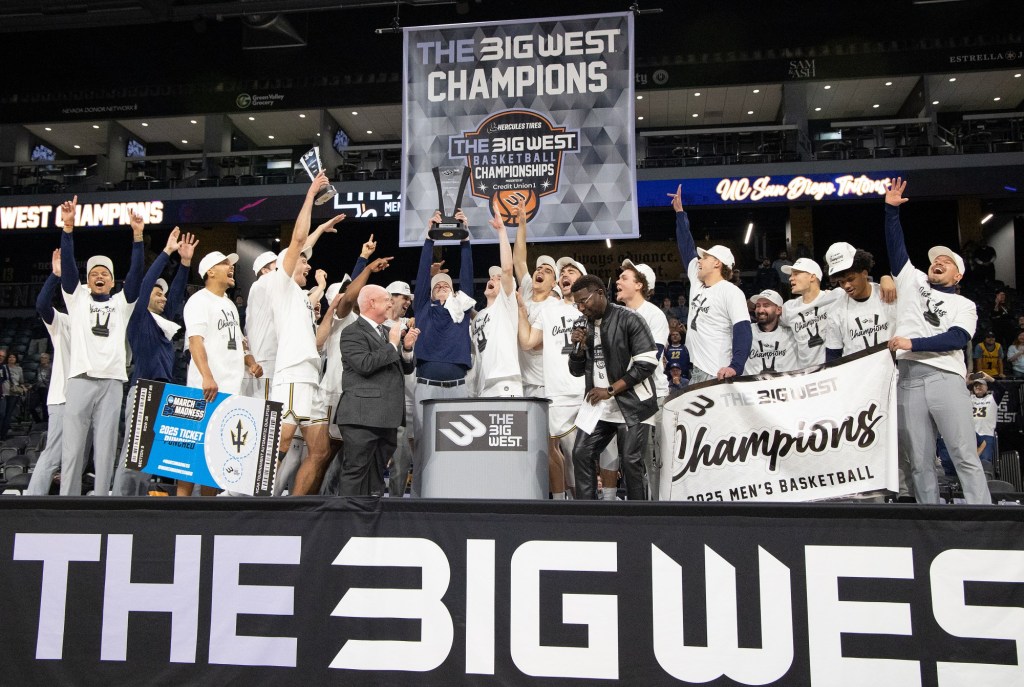Big West, we barely knew ya.
Four years after joining the conference populated with large state universities in California, just one year after attaining full-fledged Division I status and NCAA postseason access, UC San Diego is moving on … to a conference that exclusively consists of small, private, faith-based institutions.
Welcome to the new world of college athletes, where UCSD (undergraduate enrollment 33,792) can join the West Coast Conference alongside the University of San Diego (5,831) and others with as few as 2,000 undergrads.
The news began to leak out Tuesday. A formal announcement is scheduled for Wednesday. The Tritons are expected to begin play in their new league in the 2027-28 school year.
The timing is odd, considering these moves are typically announced by the athletic director and UCSD still does not have a replacement for Earl Edwards after transitioning him to Athletic Director Emeritus.
But WCC commissioner Stu Jackson, several sources said, has privately pursued UCSD for more than a year along with at least one other UC school, presumably UC Santa Barbara. The idea is to create a Southern California pod within the WCC featuring existing members USD, Pepperdine and Loyola Marymount.
The WCC has 10 members this year, but will drop to nine next summer when Gonzaga joins a reformed Pac-12 with San Diego State and four other Mountain West defectors. Grand Canyon was scheduled to join this summer but instead bolted for the Mountain West.
The last public institution to play in the WCC was Nevada, which left in 1979 and currently belongs to the Mountain West. The only other school to leave the Big West for the WCC was Pacific, a private university in Stockton, in 2013.
What’s unclear is how USD feels about all this. For years, Gonzaga blocked the addition of Seattle University because it didn’t want fan competition on that side of the state. USD may have felt similarly about an ever-expanding school nine miles away with an exponentially larger alumni base and recent Division I success in the marquee sport of men’s basketball.
For UCSD, the move seems peculiar on the surface.
It will increase travel expenses for an athletic budget that relies almost entirely on student fees, replacing van rides through Southern California (where nine Big West members are located) with plane trips to the Bay Area and Northwest.
And the path to the NCAA Tournament in men’s basketball likely got more complicated, even with Gonzaga’s departure, in a conference where several programs have far larger budgets that include charter flights to road games and, in the case of USF, housing for coaches.
But the shifting tectonic plates of college athletes have placed enormous financial burdens on the have-nots, and the fear at an aspirational school like UCSD is that the Tritons may be dragged down by the Cal State Bakersfields and CSUNs of the Big West. Incoming members Utah Valley, Cal Baptist and Sacramento State likely didn’t move the needle.
Or put another way: UCSD might have already outgrown the Big West, which is also losing UC Davis and Hawaii to the Mountain West.
“We’re a little different,” Edwards said in 2017, when UCSD first accepted the Big West’s invitation to begin play in 2020. “We’re not the new kid on the block who’s trying to crawl up. We’re the new kid who is setting the standard in terms of financial stability, in graduation rates of student-athletes. We’re going to go into the league as more or less the standard than the new kid on the block.”
UCSD does not play football, which limits its conference options. The WCC does not offer football, so that fits, although some Tritons teams (like women’s water polo and men’s volleyball) will have to find new homes.
What the WCC does provide, though, is a natural crosstown rival for the Tritons — something they’ve lacked in their years at the Division II and Division III levels.
The athletic director search, meanwhile, is expected to conclude this month. Five finalists have been identified, with the favorite considered to be former UCLA swimmer Keiko Price-Carter from Division III Emory University.
Originally Published: September 3, 2025 at 7:55 AM PDT
